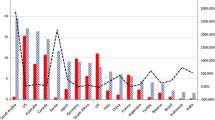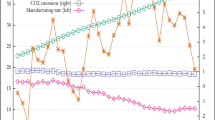Abstract
The environmental Kuznets curve (EKC) hypothesis which was developed by Grossman and Krueger implies that clean environment demand increases over a certain level of income. Convergence of carbon emission can be considered an extension of EKC hypothesis, which emphasizes that the carbon emissions of countries will converge to a certain level. Convergence is important for the identification of the trend of carbon emission and to design emission abatement policies. This study investigates the stochastic convergence of per capita carbon emission in Organization for Economic Co-operation and Development (OECD) countries for 1960–2014 under cross-sectional dependence by using recently developed panel data methods. Empirical results are as follows: (i) per capita carbon emission is generally non-stationary according to the CADF test and the CIPS test. (ii) Panel KPSS test indicates that carbon emission per capita is overwhelmingly stationary in both country-specific and panel levels; (iii) Fourier panel KPSS test indicates that per capita carbon emission is overwhelmingly stationary at the country-specific level and non-stationary at the panel level. These findings are strongly in favor of convergence of per capita carbon emission among OECD countries. Consequently, it can be said that emission abatement policies aren’t essential among these countries.


Similar content being viewed by others
References
Acaravci A, Akalin G (2017) Environment–economic growth nexus: a comparative analysis of developed and developing countries. Int J Energy Econ Policy 7(5):34–43
Acaravci A, Erdogan S (2016) The convergence behavior of CO2 emissions in seven regions under multiple structural breaks. Int J Energy Econ Policy 6(3):575–580
Aldy JE (2006) Per capita carbon dioxide emissions: convergence or divergence. Environ Resour Econ 33:533–555
Aslan A, Destek MA, Okumus I (2018) Bootstrap rolling window estimation approach to analysis of the Environment Kuznets Curve hypothesis: evidence from the USA. Environ Resour Econ 25:2402–2408
Bai J, Ng S (2001) A new look at panel testing of stationarity and the PPP hypothesis. https://dlib.bc.edu/islandora/object/bc-ir%3A103102. Accessed 30 Jan 2018
Baltagi B (2013) Econometric Analysis of Panel Data. Wiley, West Sussex
Barassi MR, Cole MA, Elliott RJR (2008) Stochastic divergence or convergence of per capita carbon dioxide emissions: re-examining the evidence. Environ Resour Econ 40:121–137
Barro R, Sala-I Martin X (1999) Economic growth. The MIT Press, Massachusetts
Becker R, Enders W, Lee J (2006) A stationarity test in the presence of an unknown number of smooth breaks. J Time Ser Anal 27:381–409
Bilgili F, Ulucak R (2018) Is there deterministic, stochastic, and/or club convergence in ecological footprint indicator among G20 countries? Environ Resour Econ 25(35):35404–35419
Bimonte S (2009) Growth and environmental quality: testing the double convergence hypothesis. Ecol Econ 68:2406–2411
Breusch TS, Pagan AR (1980) The Lagrange multiplier test and its applications to model specification in econometrics. Rev Econ Stud 47(1):239–253
Cai Y, Chang T, Inglesi-Lotz R (2018) Asymmetric persistence in convergence for carbon dioxide emissions based on quantile unit root test with Fourier function. Energy 161:470–481
Carion-i Silvestre JL, Del Barrio-Castro T, Lopez-Bazo E (2005) Breaking the panels: an application to the GDP per capita. Econ J 8:159–175
Carlino GA, Mills LO (1993) Are U.S. Regional incomes converging? A time series analysis. J Monet Econ 32:335–346
Chudik A, Pesaran MH (2013) Large panel data models with cross-sectional dependence: a survey. https://www.dallasfed.org/~/media/documents/institute/wpapers/2013/0153.pdf. Accessed 5 March 2019
Enders W (1995) Applied econometric time series. Wiley, New York
Grossman GM, Krueger AB (1991) Environmental impacts of a north American free trade agreement. The National Bureau of Economic Research. http://www.nber.org/papers/w3914.pdf. Accessed 16 June 2018
Guloglu B, Ispir S (2011) Is natural rate of unemployment or hysteresis? Sector-specific panel unit root test analysis for Turkey. Ege Acad Rev 11(2):205–215
Hadri K (2000) Testing for stationarity in heterogeneous panels. Econ J 3:148–161
Hadri K, Kurozumi E (2011) A locally optimal test for no unit root in cross-sectionally dependent panel data. Hitotsubashi J Econ 52(2):165–184
Hadri K, Kurozumi E (2012) A simple panel stationarity test in the presence of serial correlation and a common factor. Econ Lett 115:31–34
Haider S, Akram V (2019) Club convergence of per capita carbon emission: global insight from disaggregated level data. Environ Resour Econ. https://doi.org/10.1007/s11356-019-04573-9
Herrerias MJ (2012) CO2 weighted convergence across the EU-25 countries (1920–2007). Appl Energy 92:9–16
Herrerias MJ (2013) The Environmental convergence hypothesis: carbon dioxide emissions according to the source of energy. Energy Policy 61:1140–1150
Hsiao C (1985) Benefits and limitations of panel data. Econ Rev 4(1):121–174
Hsiao C (2007) Panel data analysis-advantages and ahgallenges. Test 16:1–22
Jobert T, Karanfil F, Tykhonenko A (2010) Convergence of per capita carbon dioxide emissions in the EU: legend or reality. Energy Econ 32:1364–1373
Jones PM, Enders W (2014) On the use of the flexible fourier form in unit root tests, Endogenous breaks, and parameter instability. In: Ma J, Wohar M (eds) Recent Advances in Estimating Nonlinear Models. Springer, New York, pp 59–83
Kurozumi E (2002) Testing for stationarity with a break. J Econ 108(1):63–99
Kurozumi E, Tanaka S (2010) Reducing the size distortion of the KPSS test. J Time Ser Anal 31(6):415–426
Kurozumi E, Yamazaki D, Hadri K (2013) Covariate unit root test for cross-sectionally dependent panel data. ftp://ftp.qub.ac.uk/pub/users/repec/qub/wpaper/MS_WPS_ECO_13_01.pdf. Accessed 2 Feb 2018
Lee CC, Chang CP (2008) New evidence on the convergence of per capita carbon dioxide emissions from panel seemingly unrelated regressions augmented dickey–fuller tests. Energy 33:1468–1475
Lee CC, Chang CP (2009) Stochastic convergence of per capita carbon dioxide emissions and multiple structural breaks in OECD countries. Econ Model 26:1375–1381
Li X, Lin B (2013) Global convergence in per capita CO2 emissions. Renew Sust Energ Rev 24:357–363
Li X, Tang DP, Chang T (2014) CO2 emission convergence in the 50 U.S. states-sequential panel selection method. Econ Model 40:320–333
Nazlioglu S, Karul C (2017) A panel stationarity test with gradual structural shifts: re-investigate the international commodity price shocks. Econ Model 61:181–192
Nguyen-Van P (2005) Distribution dynamics of CO2 emissions. Environ Resour Econ 32:495–508
Payne EJ, Vizek M, Lee J (2017) Stochastic convergence in per capita fossil fuel consumption in U.S. states. Energy Econ 62:382–395
Perron P (1989) The great crash, the oil price shock, and the unit root hypothesis. Econometrica 57(6):1361–1401
Pesaran MH (2007) A simple panel unit root test in the presence of cross-section dependence. J Appl Econ 22:265–312
Pesaran MH, Ullah A, Yamagata T (2008) A bias-adjusted LM Test for error cross-section independence. Econ J 11:105–127
Romer D (2012) Advanced macroeconomics. McGraw Hill, New York
Romero-Avila D (2008) Convergence in carbon dioxide emissions among industrialized countries revisited. Energy Econ 30:2265–2282
Solow R (1956) A Contribution to the theory of economic growth. Q J Econ 70(1):65–94
Soz S (1997) India rejects incorporation of new environmental commitments for developing countries. Presented at the 3rd session of the conference of the parties to the framework convention on climate change Kyoto, Japan. http://www.m2.com/m2/web/story.php/1997852568440080DDE88025683A0025702A. Accessed 19 Jan 2018
Stegman A, McKibbin WJ (2005) Convergence in per capita carbon emissions. https://www.researchgate.net/publication/5223844. Accessed 19 Jan 2018
Strazicich MC, List JA (2003) Are CO2 emission levels converging among industrial countries? Environ Resour Econ 24:263–271
Sul D, Phillips PCB, Choi CY (2005a) Prewhitening bias in HAC estimation. https://onlinelibrary.wiley.com/doi/epdf/10.1111/j.1468-0084.2005.00130.x. Accessed 18 June 2018
Sul D, Phillips PCB, Choi CY (2005b) Prewhitening bias in HAC estimation. Oxf Bull Econ Stat 67(4):517–546
U.S. Environmental Protection Agency (2015) Overview of greenhouse gasses. https://www.epa.gov/ghgemissions/overview-greenhouse-gases. Accessed 23 Jan 2018
Ulucak R, Apergis N (2018) Does convergence really matter for the environment? An application based on club convergence and on the ecological footprint concept for the EU countries. Environ Sci Pol 80:21–27
United Nations (1997) The earth summit. https://www.un.org/geninfo/bp/enviro.html. Accessed 27 April 2019
United Nations (2019) Sustainable development goals. https://sustainabledevelopment.un.org/?menu=1300. Accessed 27 April 2019
United Nations Framework Convention on Climate Change (2019a) What is the Kyoto Protocol? https://unfccc.int/process-and-meetings/the-kyoto-protocol/what-is-the-kyoto-protocol/what-is-the-kyoto-protocol. Accessed 27 April 2019
United Nations Framework Convention on Climate Change (2019b) Climate Get the big picture https://unfccc.int/resource/bigpicture/#content-the-paris-agreemen. Accessed 27 April 2019
Westerlund J, Basher SA (2008) Testing for convergence in carbon dioxide emissions using a century of panel data. Environ Resour Econ 40:109–120
Yavuz CN, Yilanci V (2013) Convergence in per capita carbon dioxide emissions among G7 countries: a TAR panel unit root approach. Environ Resour Econ 54:283–291
Author information
Authors and Affiliations
Corresponding author
Additional information
Responsible editor: Philippe Garrigues
Publisher’s note
Springer Nature remains neutral with regard to jurisdictional claims in published maps and institutional affiliations.
Rights and permissions
About this article
Cite this article
Erdogan, S., Acaravci, A. Revisiting the convergence of carbon emission phenomenon in OECD countries: new evidence from Fourier panel KPSS test. Environ Sci Pollut Res 26, 24758–24771 (2019). https://doi.org/10.1007/s11356-019-05584-2
Received:
Accepted:
Published:
Issue Date:
DOI: https://doi.org/10.1007/s11356-019-05584-2
Keywords
- Stochastic convergence
- Carbon dioxide emission
- Environmental pollution
- Fourier panel KPSS
- Panel data analysis




